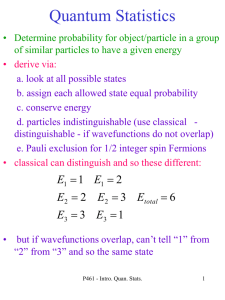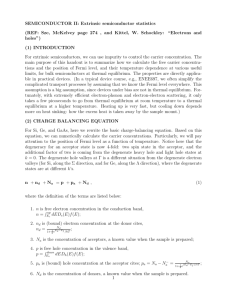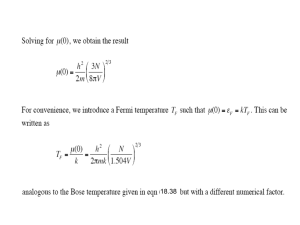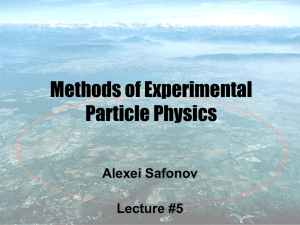Fermi Gases
advertisement
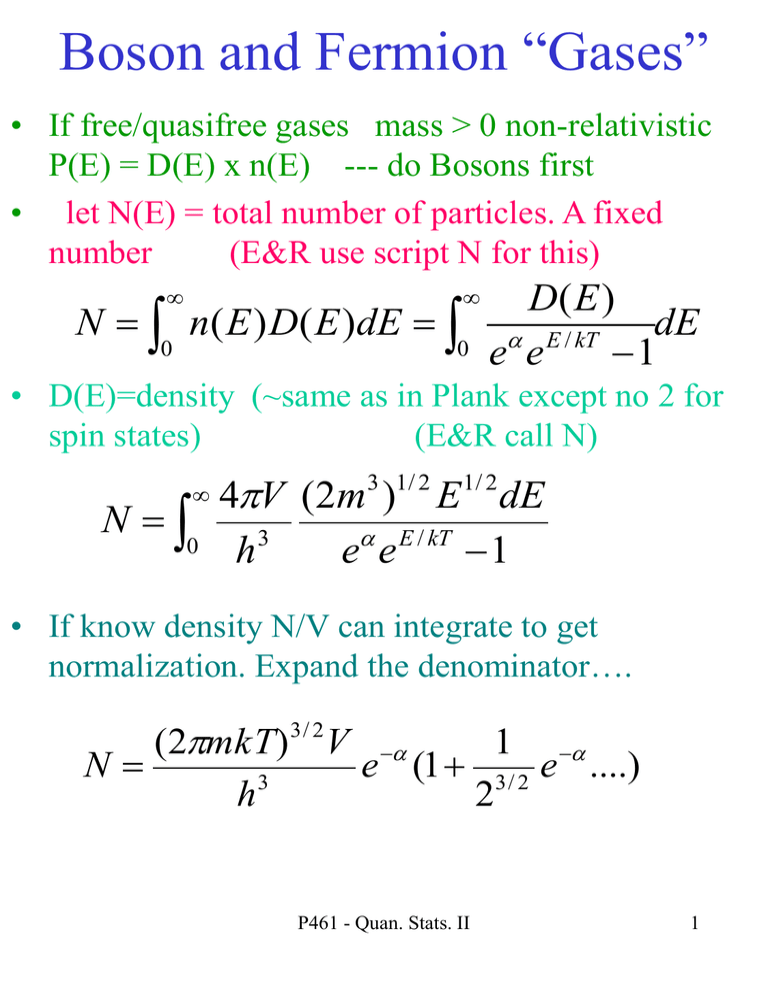
Boson and Fermion “Gases” • If free/quasifree gases mass > 0 non-relativistic P(E) = D(E) x n(E) --- do Bosons first • let N(E) = total number of particles. A fixed number (E&R use script N for this) 0 0 N n( E ) D( E )dE D( E ) dE E / kT e e 1 • D(E)=density (~same as in Plank except no 2 for spin states) (E&R call N) N 0 4V (2m3 )1/ 2 E1/ 2 dE h3 e e E / kT 1 • If know density N/V can integrate to get normalization. Expand the denominator…. (2mkT)3 / 2V 1 N e (1 3 / 2 e ....) 3 h 2 P461 - Quan. Stats. II 1 Boson Gas • Solve for e by going to the classical region (very good approximation if m and T both large) e N h3 V (2mkT )3 / 2 • this is “small”. For helium liquid (guess) T=1 K, kT=.0001 eV, N/V=.1 g/cm3 e • 3 ( 1240 eVnm ) 1022 / cm3 0.5 3/ 2 (2 4GeV .0001eV ) work out average energy 0 0 E En( E ) D( E )dE / n( E ) D( E )dE E kT (1 25 / 2 3 2 1 N h3 V ( 2mkT ) 3 / 2 ......) • average energy of Boson gas at given T smaller than classical gas (from BE distribution ftn). See liquid He discussion P461 - Quan. Stats. II 2 Fermi Gas • Repeat for a Fermi gas. Add factor of 2 for S=1/2. Define Fermi Energy EF = -kT change “-” to “+” in distribution function 8V (2m3 )1/ 2 E1/ 2 n( E ) D( E ) 3 ( E EF ) / kT h (e 1) • again work out average energy 0 0 E En( E ) D( E )dE / n( E ) D( E )dE E kT (1 25 / 2 3 2 1 N h3 V ( 2mkT )3 / 2 ......) • average energy of Fermion gas at given T larger than classical gas (from FD distribution ftn). Pauli exclusion forces to higher energy and often much larger P461 - Quan. Stats. II 3 Fermi Gas • Distinguishable <---> Indistinguishable Classical <----> degenerate • depend on density. If the wavelength similar to the separation than degenerate Fermi gas particle separation n h p 1 / 3 • larger temperatures have smaller wavelength need tighter packing for degeneracy to occur • degenerate electron examples - conductors and semiconductors - pressure at Earth’s core (at least some of it) -aids in initiating transition from Main Sequence stars to Red Giants (allows T to increase as electron pressure is independent of T) - white dwarves and Iron core of massive stars • Neutron and proton examples - nuclei with Fermi momentum = 250 MeV/c - neutron stars P461 - Quan. Stats. II 4 Degenerate vs non-degenerate P461 - Quan. Stats. II 5 Conduction electrons • Most electrons in a metal are attached to individual atoms. • But 1-2 are “free” to move through the lattice. Can treat them as a “gas” (in a 3D box) • more like a finite well but energy levels (and density of states) similar (not bound states but “vibrational” states of electrons in box) • depth of well V = W (energy needed for electron to be removed from metal’s surface photoelectric effect) + Fermi Energy • at T = 0 all states up to EF are filled W V EF Filled levels P461 - Quan. Stats. II 6 Conduction electrons • Can then calculate the Fermi energy for T=0 (and it doesn’t usually change much for higher T) T=0 n N n( E ) D( E )dE 0 EF 0 2 8V (2m 3 )1/ 2 D( E )dE 2h 3 EF • h 3N 8m V 2 EF 0 E 1/ 2 dE E 2/3 Ex. Silver 1 free electron/atom N 6.02 10 23 atoms / mole 10.5 g 1e V 108 g / mole cm 3 atom 5.9 10 22 free electrons / cm 3 EF 34 (6.6 10 joule sec) 8 9.1 10 31 kg or E F 2 3 5.9 10 3 m (1240eVnm) 3 5.9 10 8 .511MeV m 3 2 P461 - Quan. Stats. II 28 28 2/3 1eV 1.6 10 19 J 2/3 5.5eV 7 Conduction electrons • Can determine the average energy at T = 0 E EF E D( E )n( E )dE 0 EF 0 EF E E 1/ 2 dE 0 D( E )n( E )dE EF 0 E 1/ 2 dE EF5 / 2 52 3 3 / 2 2 EF EF 3 5 • for silver 3.3 eV • can compare to classical statistics 3.3eV 3.3eV o T 40 , 000 K 5 k 8.6 10 eV / K • Pauli exclusion forces electrons to much higher energy levels at “low” temperatures. (why e’s not involved in specific heat which is a lattice vibration/phonons) P461 - Quan. Stats. II 8 Conduction electrons P461 - Quan. Stats. II 9 Conduction electrons • Similarly, from T-dependent 3 1 Nh3 E kT 1 5 / 3 .... 3/ 2 2 2 V (2mkT) • the terms after the 1 are the degeneracy terms….large if degenerate. For silver atoms at T=300 K 3 E kT 1 820 2 • not until the degeneracy term is small will the electron act classically. Happens at high T • The Fermi energy varies slowly with T and at T=300 K is almost the same as at T=0 EF (300) EF (0) • You obtain the Fermi energy by normalization. Quark-gluon plasma (covered later) is an example of a high T Fermi gas P461 - Quan. Stats. II 10 Fermi Gases in Stars • Equilibrium: balance between gravitational pressure and “gas” (either normal or degenerate) pressure • total gravitational Energy: GM ( r) Mass ( r r) E r R r ( r) 2 E G 4r dr 4r 2 ( r )dr 0 0 r E 3 M 2G if cons tan t pressure V 5 R • density varies in normal stars (in Sun: average is 1 g/cm3 but at r=0 is 100 g/cm3). More of a constant in white dwarves or neutron stars • will have either “normal” gas pressure of P=nkT (P=n<E>) or pressure due to degenerate particles. Normal depends on T, degenerate (mostly) doesn’t • n = particle density in this case P461 - Quan. Stats. II 11 Degenerate Fermi Gas Pressure • Start with p = n<E> • non-relativistic relativistic density states : D ( p ) p 2 both cases D( E ) E1/ 2 N EF 0 E2 1/ 2 AE dE EF n 2 / 3 E EF 0 AE 2dE EF n1 / 3 1/ 2 E E dE 1/ 2 E dE E 53 EF K1n 2 / 3 P K1n n 2 / 3 n 5 / 3 2 E E dE 2 E dE 43 EF K 2n1 / 3 K 2n n1 / 3 n 4 / 3 • P depends ONLY on density P461 - Quan. Stats. II 12 Degenerate Fermi Gas Pressure non-relativistic relativistic EF n 2 / 3 EF n1 / 3 E 53 EF K1n 2 / 3 P K1n n 2 / 3 n5 / 3 43 EF K2n1 / 3 K2n n1 / 3 n 4 / 3 • P depends ONLY on density • Pressure decreases if, for a given density, particles become relativistic • if shrink star’s radius by 2 density increases by 8 gravitational E increases by 2 • if non-relativistic. <E> increases by (N/V)2/3 = 4 • if relativistic <E> increases by (N/V)1/3 = 2 • non-relativistic stable but relativistic is not. can aid in collapse of white dwarf P461 - Quan. Stats. II 13 Older Sun-like Stars • Density of core increases as HHe. He inert (no fusion yet). Core contracts • electrons become degenerate. 4 e per He nuclei. Electrons have longer wavelength than He Ee EHe thermal equilibriu m pe me mHe pHe e mHe me He • electrons move to higher energy due to Pauli exclusion/degeneracy. No longer in thermal equilibrium with p, He nuclei • pressure becomes dominated by electrons. No longer depends on T Ptotal Pe PH PHe Pe PH PHe • allows T of p,He to increase rapidly without “normal” increase in pressure and change in star’s equilibrium. • Onset of 3HeC fusion and Red Giant phase (helium flash when T = 100,000,000 K) P461 - Quan. Stats. II 14 White Dwarves • Leftover cores of Red Giants made (usually) from C + O nuclei and degenerate electrons • cores of very massive stars are Fe nuclei plus degenerate electrons and have similar properties • gravitational pressure balanced by electrons’ pressure which increases as radius decreases radius depends on Mass of star • Determine approximate Fermi Energy. Assume electron density = 0.5(p+n) density N M Sun 1 1 5 1035 e / m 3 V m p 2 volume Earth E F (non rel ) E F (rel ) hc h2 N 3 2 / 3 8m V N 3 1/ 3 V 8 0.3 MeV 0.8 MeV • electrons are in this range and often not completely relativistic or non-relativistic need to use the correct E2 = p2 + m2 relationship P461 - Quan. Stats. II 15 White Dwarves + Collapse • If the electron energy is > about 1.4 MeV can have: e p n EThreshold 1.4MeV • any electrons > ET “disappear”. The electron energy distribution depends on T (average E) #e’s EF ET • the “lost” electrons cause the pressure from the degenerate electrons to decrease • the energy of the neutrinos is also lost as they escape “cools” the star • as the mass increases, radius decreases, and number of electrons above threshold increases P461 - Quan. Stats. II 16 White Dwarves+Supernovas • another process - photodisentegration - also absorbs energy “cooling” star. Similar energy loss as e+p combination 56Fe 134 He 4n He 2 p 2n 4 • At some point the not very stable equilibrium between gravity and (mostly) electron pressure doesn’t hold • White Dwarf collapses and some fraction (20-50% ??) of the protons convert to neutrons during the collapse • gives Supernovas LSN (light ) 109 LSun (light ) LSN (neutrinos ) 100(1000 ?) LSN (light ) P461 - Quan. Stats. II 17 White Dwarves+Supernovas P461 - Quan. Stats. II 18 Neutron Stars-approx. numbers • Supernovas can produce neutron stars - radius ~ 10 km - mass about that of Sun. always < 3 mass Sun - relative n:p:e ~ 99:1:1 • gravity supported by degenerate neutrons N 2 M Sun V mn 1 44 3 3 6 10 / m . 6 / F 4 (10 km) 3 3 separation 1.2 F • plug into non-relativistic formula for Fermi Energy 140 MeV (as mass =940 MeV, non-rel OK) • look at wavelength h h 1240MeVF 2F p 2mE 2 940MeV 140MeV • can determine radius vs mass (like WD) • can collapse into black hole P461 - Quan. Stats. II 19 Neutron Stars • 3 separate Fermi gases: n:p:e p+n are in the same potential well due to strong nuclear force • assume independent and that p/n = 0.01 (depends on star’s mass) EF ( p) EF (n) VN 2/3 EF (e) EF (n) VN 14525MeV 6MeV 2 / 3 mn me 14525MeV 940 .5 10,000MeV ( wrong ) • so need to use relativistic for electrons EF (e) N 3 1/ 3 V 8 hc 500MeV • but not independent as p <---> n n p e p n e p e n n e p • plus reactions with virtual particles • free neutrons decay. But in a neutron star they can only do so if there is an available unfilled electron state. So suppresses decay P461 - Quan. Stats. II 20 Neutron Stars • Will end up with an equilibrium between n-p-e which can best be seen by matching up the Fermi energy of the neutrons with the e-p system • neutrons with E > EF can then decay to p-e-nu (which raises electron density and its Fermi energy thus the balance) E F (e) E F ( p ) E F ( n ) 3n p 3ne 2 hc m p c 8 8 1/ 3 3nn 8 2/3 2/3 h2 2m p h2 mn c 2 2mn • need to include rest mass energies. Also density of electrons is equal to that of protons • can then solve for p/n ratio (we’ll skip algebra) • gives for typical neutron star: 2 1017 kg / m 3 nn 110 44 / m 3 ne n p nn / 200 P461 - Quan. Stats. II 21

